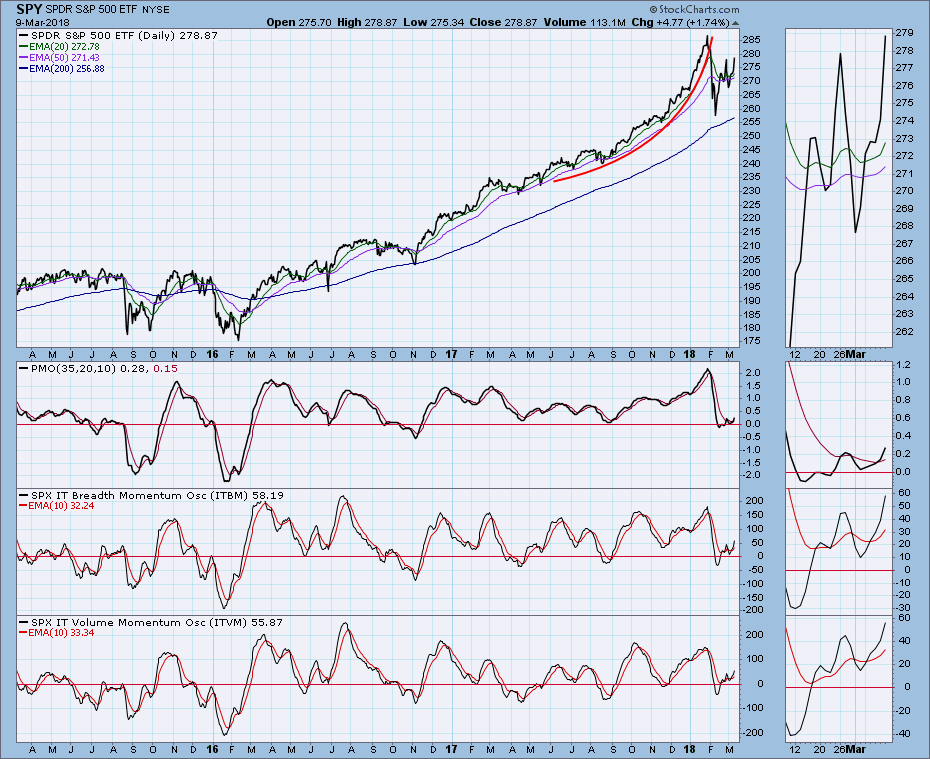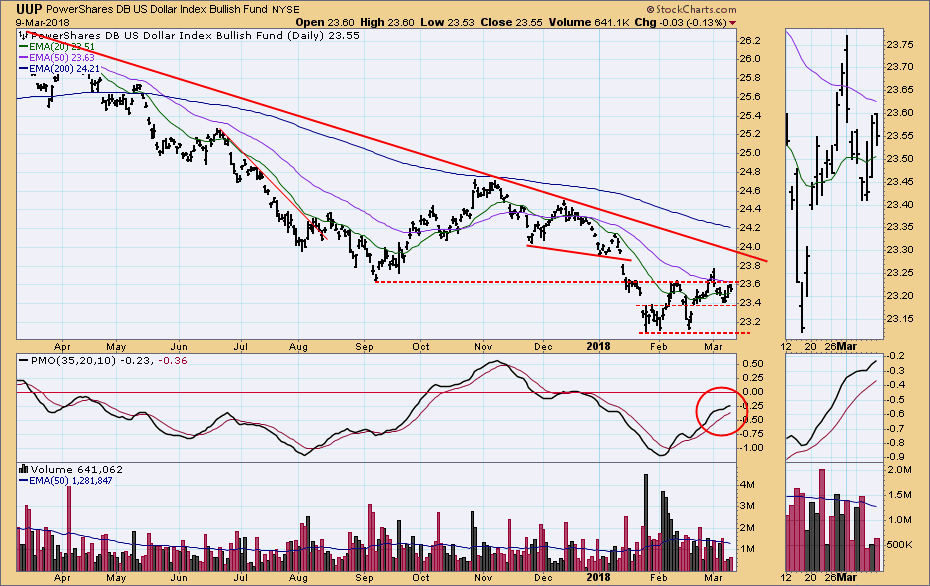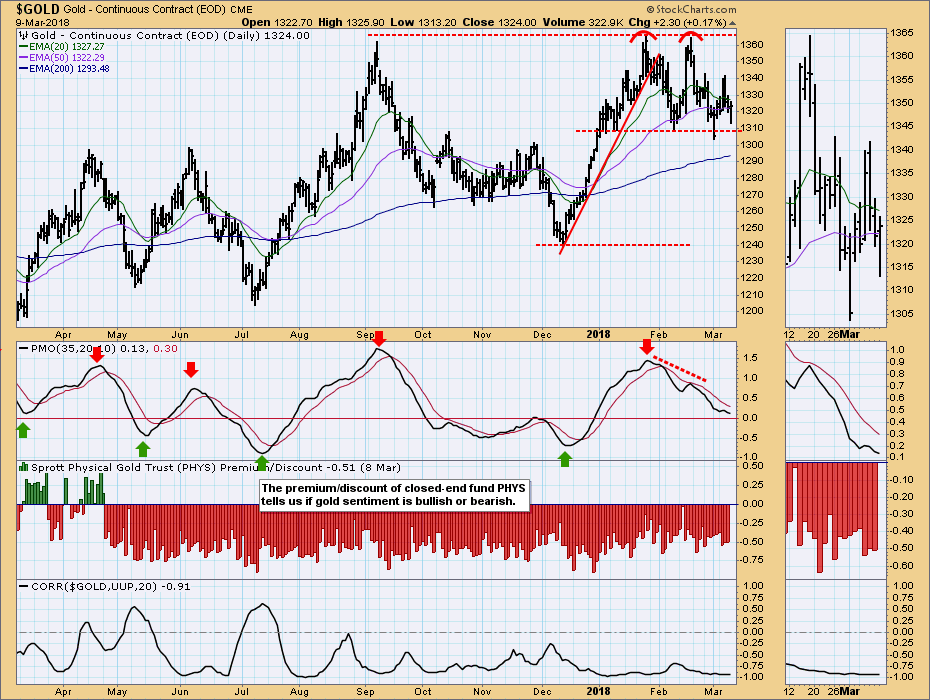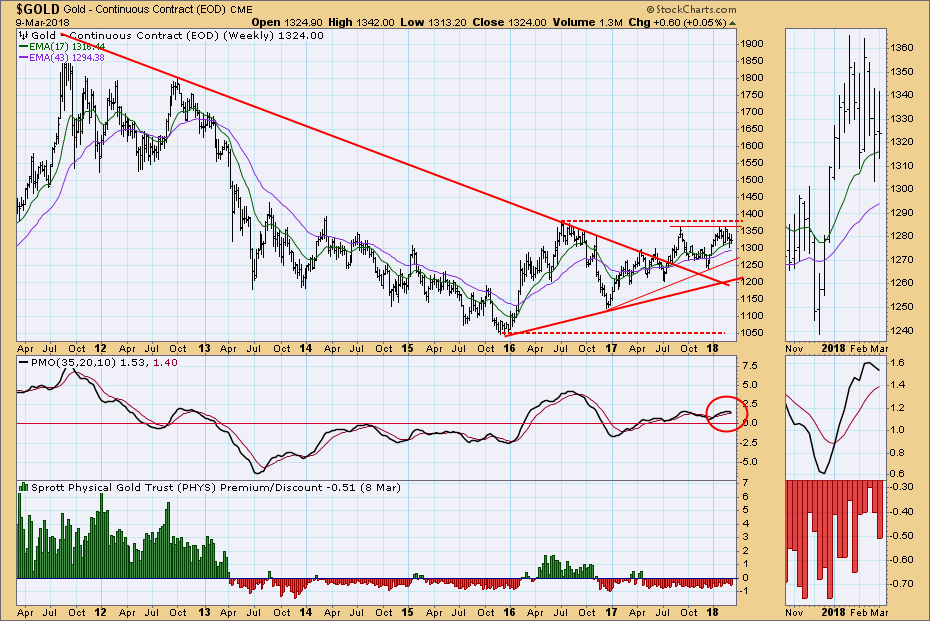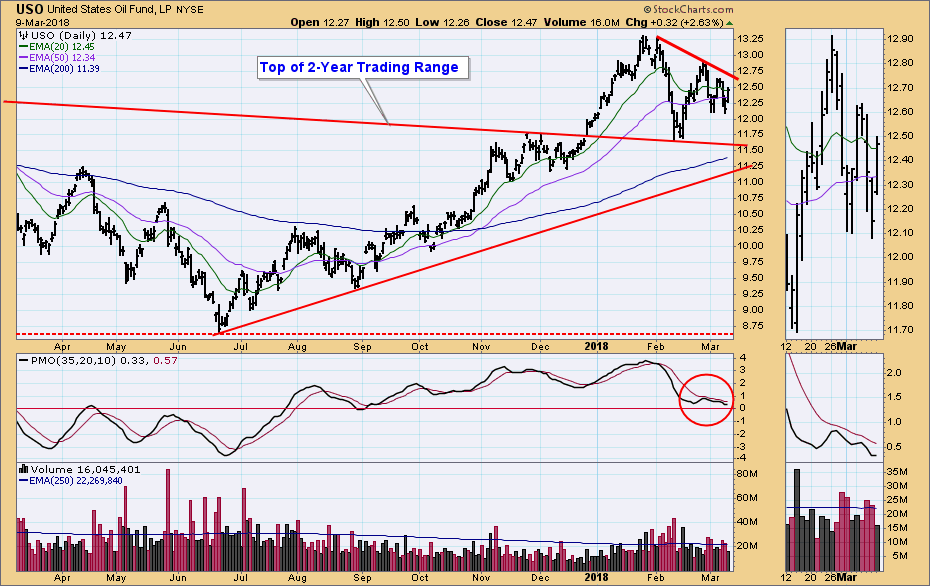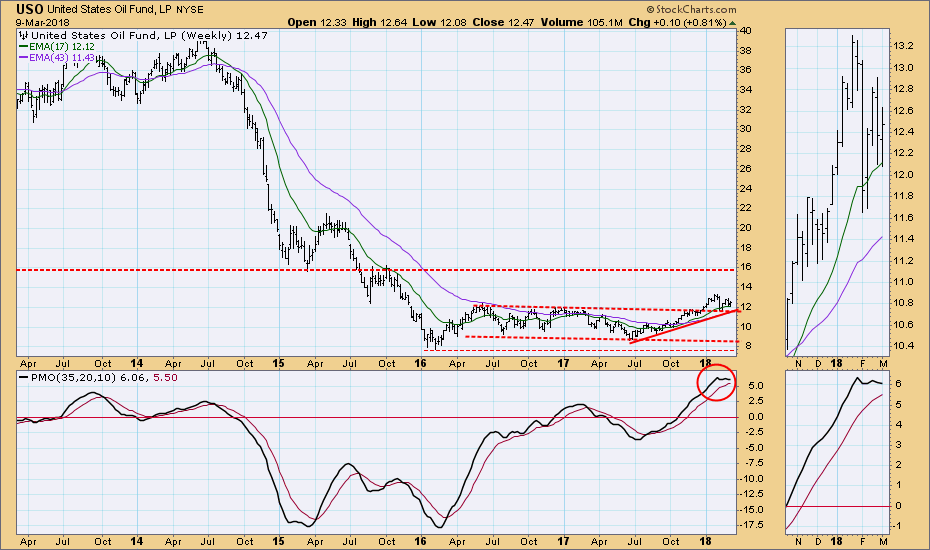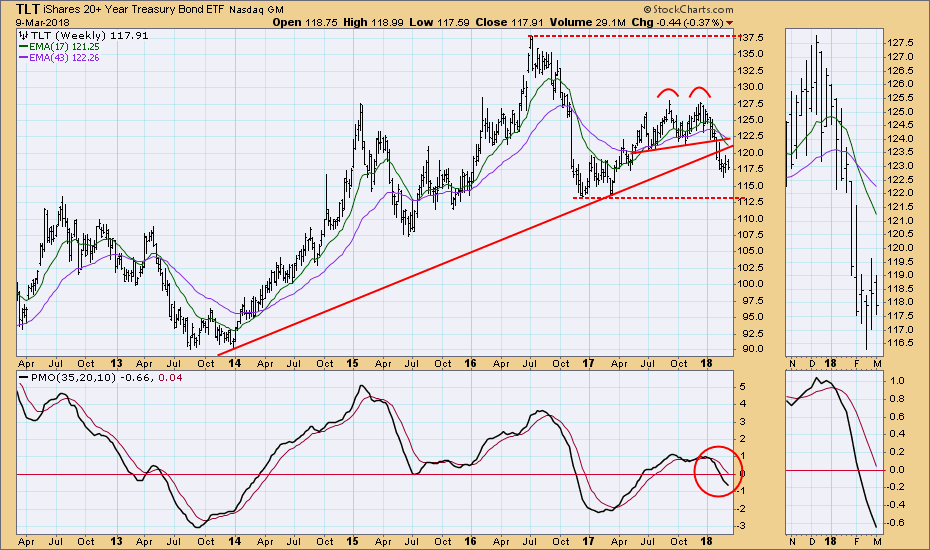
Friday was an exceptionally positive day, as prices advanced on good news regarding North Korea and jobs. Here are charts of the S&P 500 (SPY) and the 10 major sectors. The recurring theme we see is the double bottom. One exception is Utilities (XLU), which hasn't quite made the turn off the second bottom, and Technology (XLK), which actually formed a more aggressive "V" bottom. In addition, XLK has advanced to new, all-time highs this week. All the PMOs have bottomed, and most are above their signal lines. In general it looks as if we have witnessed a successful retest of the February lows. It is still possible for the market to veer into a ditch, but I think it is time for me to give up my bearish expectations.
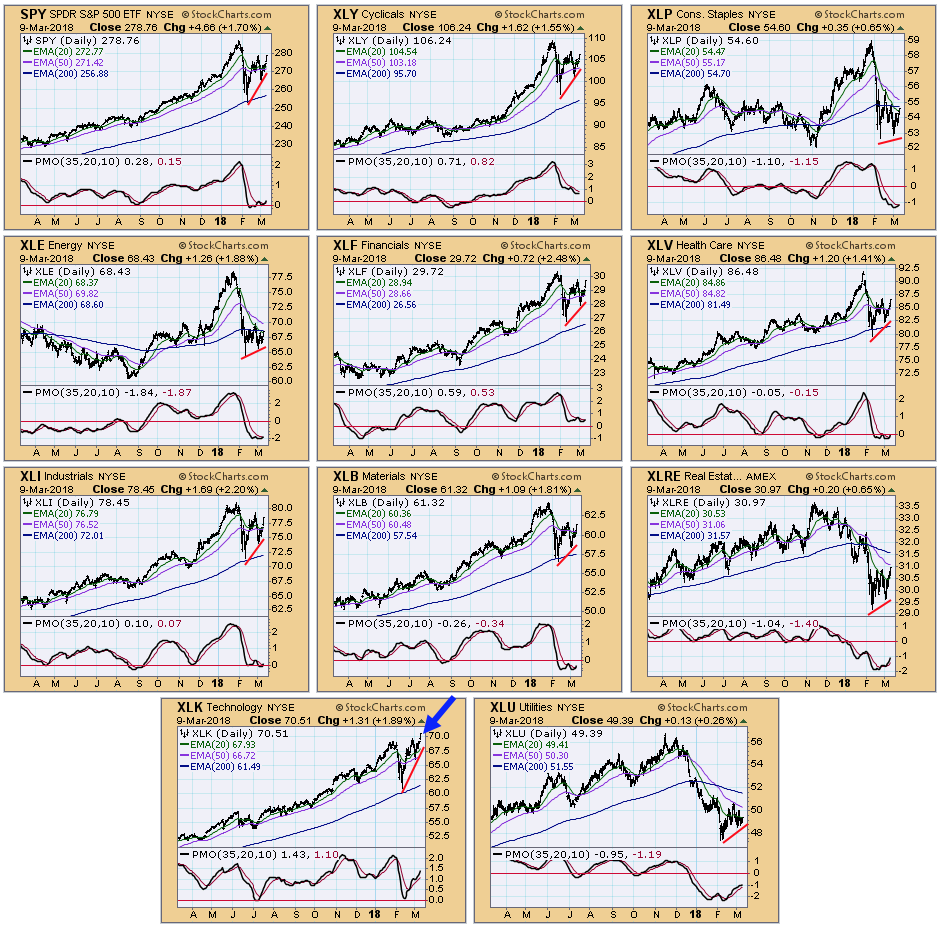
The DecisionPoint Weekly Wrap presents an end-of-week assessment of the trend and condition of the stock market (S&P 500), the U.S. Dollar, Gold, Crude Oil, and Bonds.
SECTORS
Each S&P 500 Index component stock is assigned to one, and only one, of 10 major sectors. This is a snapshot of the Intermediate-Term and Long-Term Trend Model signal status for those sectors. This week the Health Care sector changed from Neutral to BUY
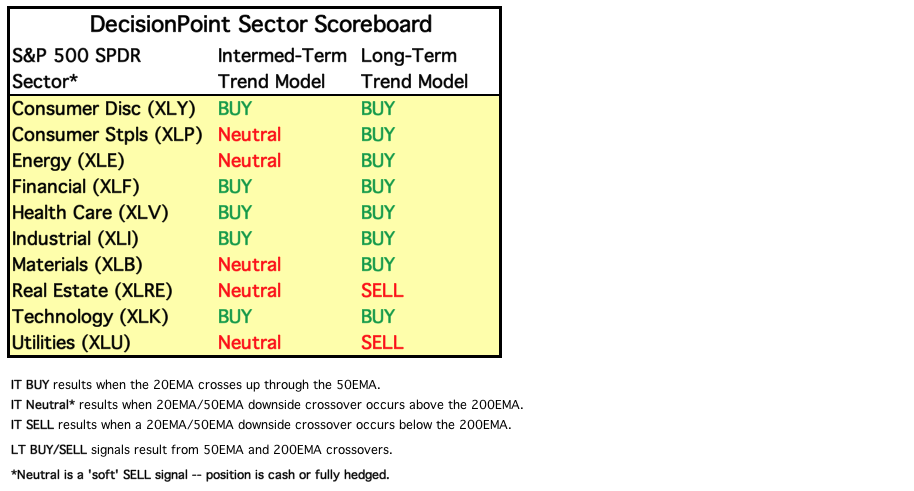
STOCKS
IT Trend Model: BUY as of 11/15/2016
LT Trend Model: BUY as of 4/1/2016
Daily Chart: SPY broke above the declining tops line drawn from the January top. S&P 500 volume on Friday was solid, but not of blowoff proportions. The daily PMO looks positive, with a long way to go before it becomes even a little overbought.
Weekly Chart: Price has again moved above the top of the rising trend channel, so that makes it overbought in this context, but the weekly PMO has turned up again.
Short-Term Market Indicators: Nearing to the top of the normal range. There is still room to accommodate more price advance. Even when the indicators top, price can still move higher, especially in a bull market.
Intermediate-Term Market Indicators: Even with a tumultuous correction, these indicators never got below the bull market range.
Conclusion: I became bearish when the parabolic advance finally broke down at the end of January, because my experience has been that parabolic breaks lead to some pretty negative price action. As we look at this one, we can see that the extreme tip of the move was corrected, which apparently is sufficient for now. The Technology sector has already gone to record highs, and maybe most of the others will follow. Nevertheless, there is still a problem. As I pointed out on the weekly chart, price has broken out of the trend channel, and on this basis it is overbought. And, even though the parabolic was corrected, the current rate of ascent is not sustainable. One possible, and desirable, scenario would be for the market to churn sideways in a 5% to 10% range for several months in order to digest some of the excesses, but who knows? The point is that we appear to have dodged a bullet by recovering from the parabolic breakdown, but if the market doesn't curb the speed of this advance, another bullet can't be far behind.
DOLLAR (UUP)
IT Trend Model: SELL as of 12/21/2017
LT Trend Model: SELL as of 5/24/2017
Daily Chart: Since late-January price has been consolidating and has even turned slightly positive.
Weekly Chart: A large falling wedge pattern, a weekly PMO bottom, and the bounce off long-term support are all painting a positive picture in this time frame.
GOLD
IT Trend Model: BUY as of 1/2/2018
LT Trend Model: BUY as of 4/12/2017
Daily Chart: Last week the double top pattern seemed to have executed as price broke below the confirmation line. Price has since recaptured the support line, but price action remains weak.
Weekly Chart: The weekly PMO has topped, but it has been running flat for about a year, so the implication is not as bearish as it would be in another configuration. The EMAs are solidly bullish.
CRUDE OIL (USO)
IT Trend Model: BUY as of 9/6/2017
LT Trend Model: BUY as of 11/2/2017
Daily Chart: The dominant pattern for two months is a falling wedge, a pattern that usually resolves upward.
Weekly Chart: After breaking above the two-year trading channel in December, USO has been in consolidation mode. The problem I'm seeing here is that the weekly PMO is overbought and trying to top.
BONDS (TLT)
IT Trend Model: NEUTRAL as of 1/11/2018
LT Trend Model: SELL as of 2/8/2018
Daily Chart: After a decline from the breakdown through the double top confirmation line, TLT has been consolidating for several weeks. TLT has not reached the minimum downside target, so I am assuming that price will head lower soon.
Weekly Chart: This chart is still bearish, and long-term support is drawn across the previous double bottom.
**Don't miss any of the DecisionPoint commentaries! Go to the "Notify Me" box toward the end of this blog page to be notified as soon as they are published.**
Technical Analysis is a windsock, not a crystal ball.
Happy Charting!
- Carl
NOTE: The signal status reported herein is based upon mechanical trading model signals, specifically, the DecisionPoint Trend Model. They define the implied bias of the price index based upon moving average relationships, but they do not necessarily call for a specific action. They are information flags that should prompt chart review. Further, they do not call for continuous buying or selling during the life of the signal. For example, a BUY signal will probably (but not necessarily) return the best results if action is taken soon after the signal is generated. Additional opportunities for buying may be found as price zigzags higher, but the trader must look for optimum entry points. Conversely, exit points to preserve gains (or minimize losses) may be evident before the model mechanically closes the signal.
Helpful DecisionPoint Links:
DecisionPoint Shared ChartList and DecisionPoint Chart Gallery
Price Momentum Oscillator (PMO)
Swenlin Trading Oscillators (STO-B and STO-V)




